8Aunit6表格式教案
- 格式:doc
- 大小:169.00 KB
- 文档页数:9
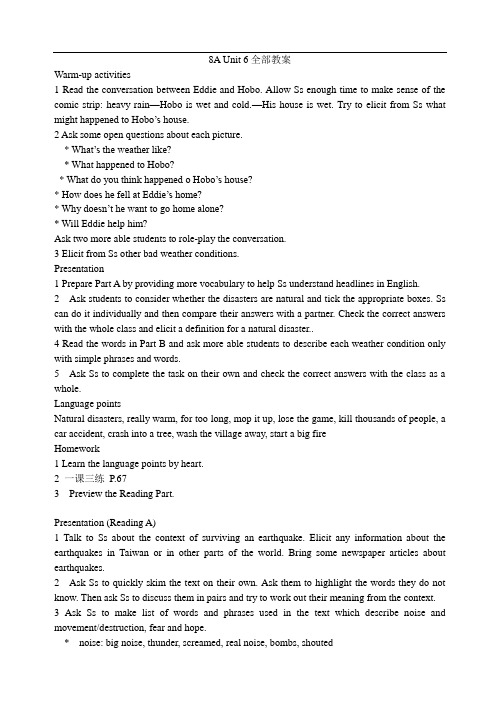
8A Unit 6全部教案Warm-up activities1 Read the conversation between Eddie and Hobo. Allow Ss enough time to make sense of the comic strip: heavy rain—Hobo is wet and cold.—His house is wet. Try to elicit from Ss what might happened to Hobo’s house.2 Ask some open questions about each picture.* What’s the weather like?* What happened to Hobo?* What do you think happened o Hobo’s house?* How does he fell at Eddie’s home?* Why doesn’t he want to go home alone?* Will Eddie help him?Ask two more able students to role-play the conversation.3 Elicit from Ss other bad weather conditions.Presentation1 Prepare Part A by providing more vocabulary to help Ss understand headlines in English.2 Ask students to consider whether the disasters are natural and tick the appropriate boxes. Ss can do it individually and then compare their answers with a partner. Check the correct answers with the whole class and elicit a definition for a natural disaster..4 Read the words in Part B and ask more able students to describe each weather condition only with simple phrases and words.5 Ask Ss to complete the task on their own and check the correct answers with the class as a whole.Language pointsNatural disasters, really warm, for too long, mop it up, lose the game, kill thousands of people, a car accident, crash into a tree, wash the village away, start a big fireHomework1 Learn the language points by heart.2 一课三练P.673 Preview the Reading Part.Presentation (Reading A)1 Talk to Ss about the context of surviving an earthquake. Elicit any information about the earthquakes in Taiwan or in other parts of the world. Bring some newspaper articles about earthquakes.2 Ask Ss to quickly skim the text on their own. Ask them to highlight the words they do not know. Then ask Ss to discuss them in pairs and try to work out their meaning from the context.3 Ask Ss to make list of words and phrases used in the text which describe noise and movement/destruction, fear and hope.* noise: big noise, thunder, screamed, real noise, bombs, shouted* movement/destruction: slight shaking, earth started to shake, ran (wildly), pieces of glass and bricks fell down, walls began to come down* fear: screamed, frightened, dark, could not at all, a moment of fear* hope: calm down, still alive, bright daylight, safe4 Read Timmy’s story aloud. Ask Ss to listen carefully.5 Check general understanding of the different paragraphs by asking some ‘ wh-‘ questions. Para 1: Where was Timmy?What happened in the shopping centre?Para 2: What happened to the building?How did people react?What did Timmy do?Para 3: Where was Timmy when the shaking stopped?How did Timmy feel?Para 4: What did Timmy do while he was waiting for help?Para 5: How was he rescued?Presentation (Reading B)1 Explain the context of Part B. Ask students to do Part B1 on their own. Encourage students to check their answer with a partner.3 Ask students to study the words in the box for one minute, then cover them and complete the diary entry in Part B2.Presentation (Reading C)1 Explain the context and point out to Ss the idea of telling a story with pictures. Divide the class into teams of 4-5 students to study each picture first.2 Ss write the captions in the blanks individually. Check answers with the whole class.3 Ask Ss to arrange the pictures in the right order.Presentation (Reading D)1 Explain the context and remind them about story telling from memory. Ss work in pairs to complete the task.2 Check the answers with the whole class.Language points (Part A)Feel a slight shaking through my body, a big noise like thunder, in fear, be frightened, start to shake, run in all directions, know where to go, run wildly, fall down, calm down, be over, could not see at all, be trapped, say to oneself, a moment of fear, go through my mind, since, hear excited shouts, in a great hurry, move away, see the bright daylight.Language points (Part C)Be very good at telling jokes, voteHomework1 Learn the language points by heart.2 一课三练P.68-693Preview the V ocabulary Part.当前中学英语课堂教学存在的主要问题及对策林会猛[ 摘要] :中学英语课堂教学是提高教学质量的关键。
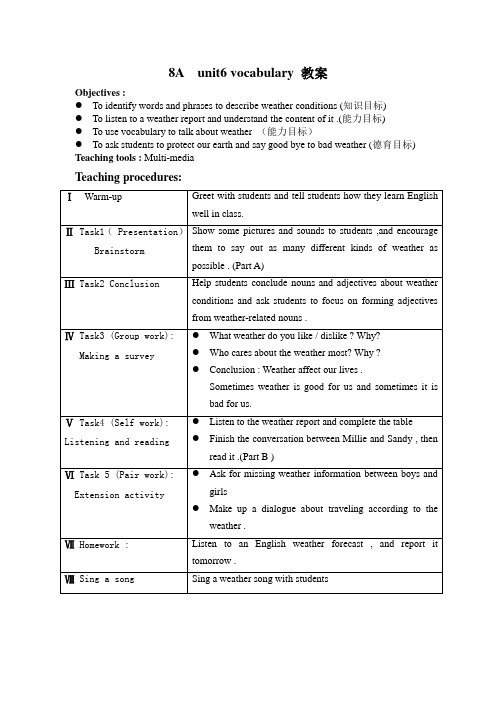
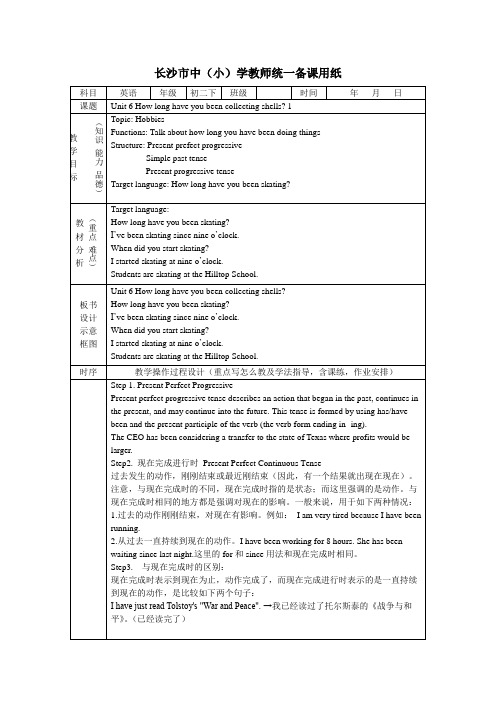
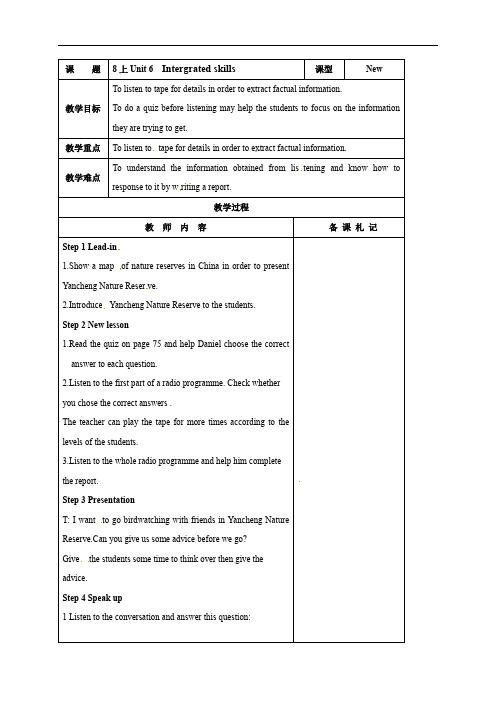
To listen to tape for details in order to extract factual information.To understand the information obtained from lis tening and know how toresponse to it by w riting a report.Step 1 Lead-in1.Show a map of nature reserves in China in order to presentYancheng Nature Reser ve.2.Introduce Yancheng Nature Reserve to the students.Step 2 New lesson1.Read the quiz on page 75 and help Daniel choose the correctanswer to each question.2.Listen to the first part of a radio programme. Check whetheryou chose the correct answers .The teacher can play the tape for more times according to thelevels of the students.3.Listen to the whole radio programme and help him completethe report.Step 3 PresentationT: I want to go birdwatching with friends in Yancheng NatureReserve.Can you give us some advice before we go?Give the students some time to think over then give theadvice.Step 4 Speak up1 Listen to the conversation and answer this question:What advice does Sandy give to Daniel?2 Read the conversation and answer more questions:What is the use of a pair of binoculars ?(It helps people see more clearly.)Why should Daniel take a notebook with him?(He can write down what he sees.)How many pieces of advice does Sandy give? (Three.)Step 5 PracticeWork in pairs and ask for advice on an activity.Step 6 Language pointscover n. 封面(C),庇护所(U) v. 覆盖,包括e.g. 湿地为野生生物提供庇护所。
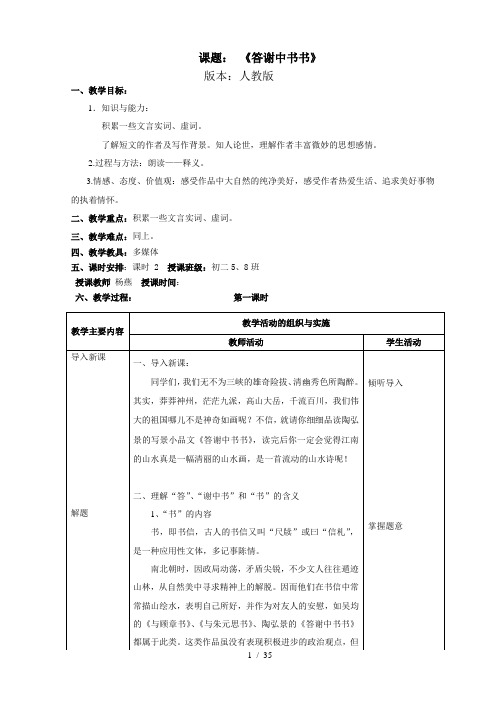
课题:《答谢中书书》版本:人教版一、教学目标:1.知识与能力:积累一些文言实词、虚词。
了解短文的作者及写作背景。
知人论世,理解作者丰富微妙的思想感情。
2.过程与方法:朗读——释义。
3.情感、态度、价值观:感受作品中大自然的纯净美好,感受作者热爱生活、追求美好事物的执着情怀。
二、教学重点:积累一些文言实词、虚词。
三、教学难点:同上。
四、教学教具:多媒体五、课时安排:课时 2 授课班级:初二5、8班授课教师杨燕授课时间:六、教学过程:第一课时教学反思:第二课时一、教学目标:知识与能力:理解文章的意境和作者的思想感情,培养学生感知写景类文章中作者思想感情的能力。
过程与方法:朗读——品析。
情感、态度、价值观:感受作品中大自然的纯净美好,感受作者热爱生活、追求美好事物的执着情怀。
二、教学重点:引导学生感受作品优美的意境,体会作品中流露的思想感情。
三、教学难点:《答谢中书书》画面布局的巧妙。
四、教学教具:多媒体五、课时安排:课时 2 授课班级:初二5、8班授课教师杨燕授课时间:六、教学过程:板书设计教学反思:课题:诗四首版本:人教版一、教学目标:1.知识与能力:整体感知这诗歌,了解诗的写作背景,作者生平、思想,律诗的一些常识。
2.过程与方法:通过反复读诗,让学生在吟咏之中加深理解,熟读成诵,品味诗歌语言。
3.情感态度与价值观:培养学生热爱祖国古代文化的思想感情,提高文化品位和审美情趣。
二、教学重点:熟读成诵,理解作者所表达的思想感情。
三、教学难点:理解诗句所蕴涵的内涵,体会诗歌意境。
四、教学教具:多媒体五、课时安排: 4课时授课班级:初二5、8班授课教师:杨燕授课时间:六、教学过程:第一课时教学反思:第二课时一、教学目标:1.知识与能力:整体感知诗歌,了解诗的写作背景,作者生平、思想,律诗的一些常识。
2.过程与方法:通过反复读诗,让学生在吟咏之中加深理解,熟读成诵,品味诗歌语言。
3.情感态度与价值观:培养学生热爱祖国古代文化的思想感情,提高文化品位和审美情趣。
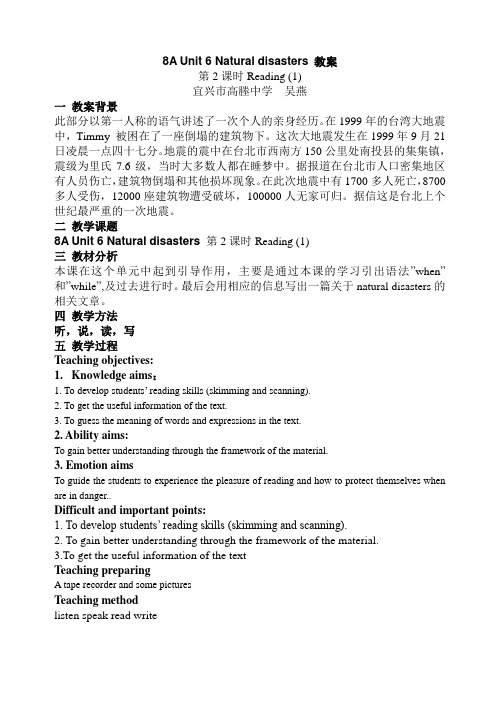
8A Unit 6 Natural disasters 教案第2课时Reading (1)宜兴市高塍中学吴燕一教案背景此部分以第一人称的语气讲述了一次个人的亲身经历。
在1999年的台湾大地震中,Timmy 被困在了一座倒塌的建筑物下。
这次大地震发生在1999年9月21日凌晨一点四十七分。
地震的震中在台北市西南方150公里处南投县的集集镇,震级为里氏7.6级,当时大多数人都在睡梦中。
据报道在台北市人口密集地区有人员伤亡,建筑物倒塌和其他损坏现象。
在此次地震中有1700多人死亡,8700多人受伤,12000座建筑物遭受破坏,100000人无家可归。
据信这是台北上个世纪最严重的一次地震。
二教学课题8A Unit 6 Natural disasters 第2课时Reading (1)三教材分析本课在这个单元中起到引导作用,主要是通过本课的学习引出语法”when”和”while”,及过去进行时。
最后会用相应的信息写出一篇关于natural disasters的相关文章。
四教学方法听,说,读,写五教学过程Teaching objectives:1.Knowledge aims:1. To develop students’ reading skills (skimming and scanning).2. To get the useful information of the text.3. To guess the meaning of words and expressions in the text.2. Ability aims:To gain better understanding through the framework of the material.3. Emotion aimsTo guide the students to experience the pleasure of reading and how to protect themselves when are in danger..Difficult and important points:1. To develop students’ reading skills (skimming and scanning).2. To gain better understanding through the framework of the material.3.To get the useful information of the textTeaching preparingA tape recorder and some picturesTeaching methodlisten speak read writeTeaching procedures:Step 1. Pre-checking词组翻译在一个购物中心_____________________________恐惧地互相看着______________________________破碎玻璃片_________________________________一阵恐惧___________________________________吃一包巧克力_______________________________a slight shaking _______________________________run in all directing ____________________________clam down __________________________________shout for help ________________________________stay here for a long time __________________________Step 2 Presentation1. Show some pictures of natural disasters to present the topic of this unit – natural disasters2 Present the topic of reading – earthquakeGet the students to discuss:In your opinion, what is the most dangerous kind of natural disaster?Show some pictures of earthquakes3 Teach some new words:The teacher ask the students: What happened during the earthquake?Shake, bomb, fear, scream, direction, wildly.glass.bricksStep 3 Reading1. Get the students to skim the article and find the answer to the question:Did Timmy give up or try his best to survive when he was in danger during the earthquake?2 .Read the article for detailed information1) When the earthquake came, what did Timmy feel/ hear/see/do?2) How did Timmy save himself after he was trapped?3) How did other people save Timmy?3.Read the article for further understanding1) Listen to the tape and finish Exercises C, textbook Page 972) Read with feelings and finish Exercises D, textbook Page 97Step 4 Sum up1.We know about Timmy’s whole story.2.We learn some important phrases and sentences.3.We know how to save ourselves when we are in danger.Step5 Exercises & HomeworkThink of ways of saving yourself during other natural disasters, write them down . Do the exercises in Part B, Page 96.Try to say something about the main idea of the article.教学反思:通过快读,精读来回答问题,在做书本后的题目时,根据图片写句子中,第一幅图和第五幅的描述学生领会不清,part D判断正误,学生的答案85%是正确的,学生对课文内容了解,为reading的第二课时作好铺垫。
8A Unit 6 Natural disasters ReadingI .Teaching aims:Knowledge aims:1. To develop students’ reading skills (skimming and scanning).2. To get the useful information of the text.3. To guess the meaning of words and expressions in the text.Ability aims: To gain better understanding through the framework of the material. Emotional aims: To guide the students to experience the pleasure of reading and how to protect themselves when are in danger.II.Teaching keys:1. To develop students’ reading skills (skimming and scanning).2. To gain better understanding through the framework of the material. III.Teaching difficulties:To get the useful information of the textIV.Teaching methods:Task-based approach, cooperative-activities.V.Teaching aids: multi-media computer and blackboardVII.Teaching procedures:Step 1: warming-up & lead-inT: Good morning, boys and girls.S: …T: What have we learned last class?S: …1. Show some pictures of natural disasters to present the topic of this unit natural disasters (help student review)2. Present the topic of reading – earthquake.Step 2: presentation(From those pictures, can you guess if earthquake is coming, 1.what will happen to the building? 2. What kind of sound can you hear? 3. What will people do?)1.Show some pictures to help students answer the above questions.2.present new words.( Shake, bomb, fear, scream, direction, wildly)Step 3 Pre-reading (Listen and answer)1. Watch a video.(play cool)2. Listen and put the picture into correct order (Part D, P. 97).Step 4 Fast-reading1. Read the article for detailed information (Do T or F)Step 5 Intensive-reading (Read and answer)1.Read the article for further understanding2.Fill the following chart.Step 6: Practice & Consolidation1. Play the tape for the students to listen and repeat. Then get the students to read the article loudly.2. Ask the students to discuss: How to save yourselves when you are in danger?3.First ,I will show some pictures to them. Let them write down their feelings.(work in pairs, let students make a interview)S1: What can you see form this picture?S2: …S1: what do you feel after seeing this ?S2:S1: What will you do to help the alive people?S2: Show our love and ……4.Let them act it out.Step 7: Homework1. Surf the Internet to find more information about how to protect yourself and help others when you are in danger, write it down.How he feltWhat he heardWhat he sawWhat he did Where he was Finally At first Then。
8A Unit 6 Natural disasters主备人:灌南县实验中学张海霞执教人:执教班级:执教时间:年月日Content:Comic strip & Welcome to the unitPeriod:10-1Teaching aims and demands:learn the new words and phrases.2. To meet the past continuous tense.3. To talk about different weather. , learn how to name and describe natural disasters.4. To teach the students to obey the traffic rules and protect environment.Key points:To learn the new words about different weather and natural disasters.To describe natural disasters.Difficult points:Describe the natural disasters and the past continuous tense.Teaching aids:a tape recorder and some picturesTeaching methods:Discussion and communication.Teaching procedures:达标检测Unit 6 Comic strip & Welcome to the unit (30’)一、根据对话回答问题(5’)1.What’s the weather like?2.What happened to Hobo?3. What happened to Hobo’s house?4. Why doesn’t he want to go home alone?5. Will Eddie help him?二、英译汉(10’)snowy day _______________________6. thunder and lighting__________________ all wet down__________________________up away_________________________thousands of the game_______________________into big storm________________________三、用所给单词的适当形式填空。